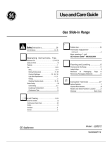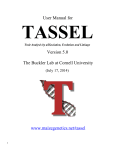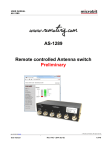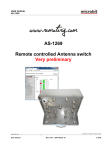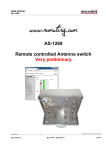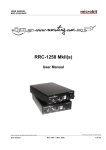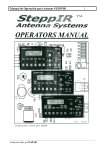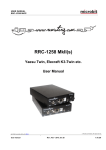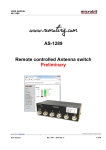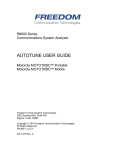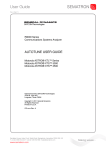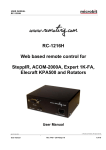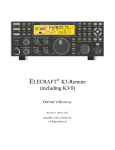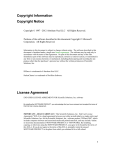Download Advances in Remote Site Control without Computers
Transcript
SHORT TAKES Radio Remote Control 1258MkII As often happens with QST “Product Reviews” and “Short Takes,” some of the best suggestions for new product reviews come from our readers. In this instance the suggestion came from Rick Hilding, K6VVA, who wanted us to take a look at the Remote Rig units being manufactured and sold by Mikael Styrefors, SM2O. Interest in remote station operating is on the upswing, driven by the fact that so many hams are facing restrictions on their ability to erect effective antennas. For some it’s a matter of local ordinances or lack of real estate, but for others it is the result of life-altering changes such as moving from homes to apartments. Thanks to products such as Mikael’s Radio Remote Control 1258MkII, a “downsized” lifestyle doesn’t have to mean abandonment of Amateur Radio. the package directly from Mikael’s Web site based in Sweden (www.remoterig.com) and it arrived within a week. One of the most elegant approaches to Internet remote control is to use a transceiver that offers a detachable front panel such as an ICOM IC-706 series, Kenwood TS-480 and so on. The front panel resides with the client while the rest of the rig remains at the host. The 1258MkIIs are specifically designed to make this type of installation as seamless as possible. By plugging in the correct cables at Removing the Computer Using the Internet to remotely control a ham station is not a new concept. However, most configurations require a computer at the radio (the “host”) to communicate with the remote operator (the “client”) and allow him to change frequencies, power levels, filter settings and so on. The computer is also needed to convert the audio signal from the radio to data for the Internet link and vice versa. The 1258MkII effectively removes the host computer from the equation. Not only does it “talk” to the transceiver for control purposes, it also handles the two-way audio stream. This makes it much easier to establish a remote station. All you need is a radio, an antenna, an Internet connection and a 1258MkII — no computer required. The 1258MkII Package SM2O’s Radio Remote Control package consists of two 1258MkII units. One is intended for installation at the host location while the other remains with the client. Both devices connect to Internet routers via Ethernet cables (one is supplied). We ordered both ends of the path, the 1258MkIIs perform the magic of linking the hardware as though you were simply connecting a very long set of control cables. If you don’t own the requisite “remotable” transceiver, you can still use the 1258MkIIs, along with a computer on the client end, to achieve the same result. For the purpose of this review, I remotely controlled a Kenwood TS-2000 with a Toshiba laptop running Ham Radio Deluxe (www.ham-radio-deluxe. com) software. The 1258MkIIs made the connection and Ham Radio Deluxe performed the control functions. As far as the software was concerned, it was connected directly to the radio through the laptop’s USB “virtual serial port.” I connected a microphone to the client 1258MkII along with a small speaker. There is no need to run Skype or other VoIP software to handle the audio connection — it is all built into the 1258MkIIs. Steve Ford, WB8IMY QST Editor Not Plug and Play Once I had the 1258MkIIs completely configured, they worked perfectly. It was remarkable to hear the audio from the remote radio pouring out of the speaker. By the same token, on-air reports of my transmit audio were outstanding. In fact, no one guessed (until I told them) that I was 10 miles from the radio. The 1258MkIIs also include a CW capability that functions surprisingly well. You simply plug your key into the unit at the client end and adjust the front panel control to set your keying speed. Since the sidetone is heard on the client side, you’re able to operate without being distracted by audio delays. All that said, it is important to point out that 1258MkII system is most definitely not plug and play. Depending on the type of transceiver and microphone you are using, you may need to construct microphone adapter cables (I did). You must also open both units and configure the wire “strapping” jumpers to permit correct microphone keying as well as the correct audio pathways. Finally, you’ll need to know how to properly configure your network routers and software firewalls to allow the 1258MkIIs to pass data from one unit to the other. If you’re not comfortable with network terminology and architecture, this could be a challenge. I’ve been working with computers for decades, so I found it straightforward. Others, however, may not. There are no manuals for the 1258MkIIs as such. Instead, the setup information exists on several pages at Mikael’s Web site. The units are well built and perform smoothly, but a comprehensive user manual, perhaps downloadable in PDF format, would be a huge benefit and would help expand their appeal beyond computer “power users.” Manufacturer: Microbit, Nystaden 1, 95261 Kalix, Sweden; www.remoterig. com. $449. Purchase must be made from Mikael’s Web site using PayPal. [email protected] May 2010 STAKES.indd 59 59 3/23/2010 11:38:21 AM If only you could operate at home with your station out at the lake ... or maybe the club's big contest station on the mountain. But you don 't like the idea of operating over a computer screen. Well, says renowned DXer OH2BH, that no longer has to be a problem . Advances in Remote Site Control without Computers BY MARTII J . LAINE,' OH2BH T he personal computer and the internet made possible the ability to remotely control an amateur radio station, and continued fine-tuning has made this capability ever more available. This benefits radio amateurs who live in antenna-restricted neigh- borhoods. poor radio locations. or places where noise issues persist. Still , many who may have wa nted 10 take advantage of remotely controlled amateur radio operation lacked an extensive knowledge of computer and! or internet architecture . A recent approach using relatively simple interconnecting devices having their own internet protocol (IP) addresses (see "First Takes: May 2010 OSn has eliminated the need for a PC on each end of the remote-eontrol circuit. The SM20 Remote Radio Contro ller (RRC) now opens the door to controlling a remote amat eur radio station virtually from anywhere there's an internet connection (WLAN or Ethernet), with or without a PC. For several years now, various radiospecific or general-purpose radio programs such as Ham Radio Deluxe have let you use your PC to remotely control a station. Audio was routed via the PC's sound ca rd with third-party software such as Skype used to ca rry it over the internet. For many, however, operating a station via a PC display with a mouse doe s not offer the same satisfying look and feel of operati ng a real radio. Employing the IP-address-based conce pt consolidates all signal paths (except RF, of course) within a single path. The RRC acts like a server at the radio end with its own IP address, allowing the remote-site unit to engage in direct two-wa y co mmunication with the 'Ss vesunamue 4C, 02380 Espoo, Finland e-maif: <martti.laine 0 kolumbus.tt» 30 . co • July 2011 Tms is all that Jaakko Silanto, OH f MA, has at home while operating his powerful remote station where large antennas and quiet reception help him work major Ox. (All photos courtesy of the author) rad io . The SM20 PC client lets you operate while on the road using nothing more than a laptop and a small USB "stick: An audio codec optimizes and di gitizes speech with good voice quality and minimized latency, all with less than 500 kbls internet speed . Look, Mal No PCI As described in the ' Flrst Takes" article last year, the RRC concept took advantage of transceivers having separable control heads, such as the Kenwood TS480 or ICOM IC-706. The head rema ined at the operating position, while the body was installed at the remote site. The latest ARC wri nkle now takes advantage of a radio's serial port (CAn to co mmand and control the same or similar radio at the remote site. The radios communicate with each other with the help of the ARC unit. This means that Radio 1 at the operating site can control The lates t version of lap top-based Remote employs an RRC PC Client which packages the needed software, audio ooaec. and PIT function into one slick unit the size of a USB memory stick. You just have to do wnload the radio software from the web and you will be in con trol of your radio wherever you are. Visit Our Web Sit. available in remote operation. Monitor· ing CW sending at the operating site is part of the RRC; thus there is no problem to deal with latency issues. It now is even possible to have different radio models on each end, as long as they use the same CAT protocol and have essentially corresponding trent-panel controls. (This new concept applies initially to the Yaesu family of radios sharing the same serial communication command base.) Applying the same approach to other manufacturers' radiosshould be easy,and I believe that future radios will incorporate these features or offer them as an option. Amplifier and Rotator Remote Control Control and remote RRC units utilize three communication channels; a simple text-based SIP protocol is utilized for radio-to-radio communication, while a UDP datagram protocol is used for control and audio streams. The RRC unit also provides two additional serial pons for connecting devices such as an amplifier and a rota tor control. all functions of Radio 2 at the remote (i.e., antenna) site, just as if the entire station were at the operating site. When Radio 1 switches or tunes the bands, so does Radio 2. But hold on! It gets even more exciting. The radio at the operating position can even display S- meter readings from the remote radio by using a calibrated S-meter table. Even the power switch-turning the radio on or off at home-will tum the radio on or off at the remote site. The latest ARC has added CW capability, including a keyer, so that smooth CW would also be Until now, operating a remote-site amplifier or beam rotator typically has involved your logging computer at the operati ngsite. But even here new winds are blowing, so it is reasonable to have an amplifier than can be truly controlled and monitored over the internet using an HTTP approach. Here you should have web-browser-based software on your logging PC that enables the PC to communicate with an amplifier having an I? address, to set and show uscoeration on a real-time basis. Radio Arcata (OH8X), a Finnish high· tech consortium, jointly undertook with Advanced Remote Station - III CC: OM Remot. Conlrol Unll BO [~=I ~--I 0 0 01 • " DSL ..od. ... . . . . .H R_ le _ER CO..lh oi Unit CAT FT4ERIES Paddle The o verall sta tion layout connects all necessary building blocks together in a simple way tha t taday 's ham operators are bound to know in the contempora ry intemet·dominated world. Changing between local operation and remote operation is as easy as changing the microp hone and headphones. No RF or data-rela ted cables need to be touched. 32 - CO - July 2011 Visit Our Web Site the European OM-Power amplifier manufacturer to work out such a concept-the first of its kind. It lets you communicate with the amplifier over the internet and see its functions just as though the amplifier were sittinq on your operating table. Here the amplifier is not connected to a local computer as currently is often done through an RS-232 port; rather it is hooked up directly with the internet. Radio Arcala <1'1ttp:Jlwww. radioarcala.ccm> offers the needed open-source software. Only a few commercial rotators currently fit into the remote-eontrol scheme. although Yaesu's DXA series can be an integral part of the radio and therefore can be controlled from the radio itself. While IP-addressed interface boards are just becoming available for standard rotators, all requisite technologies and building blocks are avail- Several of the hams working to make traditional amplifier technology and latest IP technology talk to one another. From left: Toni Linden. OH2UA ; Martti Laine, OH2BH; Tibi Ferenec, OM3RM; Ivan Miroslav, OM3LZ; and Jozef Lang. OM3GI. Adding an IP-based radio controfJer and amplifier interlace to your station will not change the traditional layout or assume extra space or heavy wiring but will keep your station's operating convenience and ergonomics intact. It is noted that in some cases, the operator has reappeared among the family members with his laptop (but is stilf on the air!). www.cq-amateur-radio.com July 2011 • CO • 33 • Remote Station Vocabulary Remote Rad io : A remote site controlled from elsewhere. Control Head : Where the remote radio is controlled by radio software or with another radio. IP Add ress : An Internet Protocol Address is a numerical label assigned 10 each device participating in a computer networx thai uses the Internet Protocol for communication. An IP address serves two principal functions: host or network interface identificat ion and loca tion addressing. Its role has been characterized as follows: "A name indicates what we seek. An address indicates where it is. A route indicates how 10 get there." HTIP: The acronym lor Hyper Text Transfer Protocol, the underlyin g protocol used by the Wo rld Wide Web. HTTP defines how messages are formatted and transmitted, and what actions web servers and browsers should take in response 10 various commands. For example, when you enter a UAL in your browser, this actually sends an HITP command to the web server, directing it to letch and transmit the requestecl web page. Latencv: latency is Simply definecl as the time delay observed as data transmits from one point to another. Usually, to determine networi< latency the origin and destination points are used. A so-called Iow-latency network connection is one that generally experiences small delay limes,wh ile a high-latency connection generally suflers from long delays. 500-ms latency is widely used as the limit for speech. SIP: session Initiation Protocol , a very simple text-based application-layer control pro10001. It creates, mod ifies, and terminates sessions with one or more participants. UD P: Un iversal Datagram Protocol , a protocol to transfer sequential data over data networks. URL: Un iform Resource Locator, the technical name for the add ress where a specific web page is found . Vo IP: Voice over Internet Protocol; general definition of voice services delivered ove r IP networks. a ble 10 allow the remote station to p lay sim ply a nd efficiently . O nce again, none of the elem e nts u sed here sug gest that you ha ve to communicate with a PC at the re mote site . a n issue that typically ha s been a source of m any shortcomings a nd hassle s . IP Addressabilily is King T he key to a remote w o rld is hav ing all rad io s a nd sta tio n ac c ess o rie s IP a ddressable. T his perm its the opera to r to cont rol the m loca lly o r remotely in the same fash ion. This scenario is coming soon , prompted by hardw a re and software o ptions on hand today . The IP initiative fo r hardware ra dios ha s been p resented to the radio manufacturing industry, a nd the RJ jac k w ith related ci rcuitry soon will a llo w you to hook up each p iece of yo u r station gear w ith the internet. Realiz ing t he m ag ic of SM 20 's approach , Ra dio Arcata had the vision to incorporate this s ma rt concept into fullfeatured radio s and d evoted its application knowledge for the co m mo n good. Remote Radio Controller (RRC) A Technical View RRC is an intuitive way of utilizing existing Vol P technology. The connection establiShed between the control end and the radio end uses the woOd standard session initiation protcx:ol (SIP). RRC boxes are buih around reliable ARM microprocessor technology which interface with Ethemet networking, digita l input/output (serial ports and PITICW) , and audio channels for transmit/receive audio. Audio coding in AR C features low latency , as there is really no processing power available to do compressed aud io coding which would add audio coding/decoding but save network bandwidth. Several audio quality levels are available , even for low network speeds below 100 kbit/s. Better auclio quality means more network bandwidth ; highest qualily consumes over 300 kbit/s network bandwidth but offers very good audio quality and dynamics. The latest version of Remoterig devices also feature dual audio channels to deliver both ma in and auxiliary receiver audio to the control end. RRC comes with three serial ports which are tied together with the corresponding ports on the device at the other end; serial-port tralfic flows multiplexed in the control data stream among PIT and CW information. RRC functions well over lirewalls and NAT technology, which is widely used in home broadband network routers, etc., from a single add ress which is managed by the broadband router. The router takes ca re of directing the inbound return traffic from the internet to the right machine s. A Remoterig session is always established by the control end, which creates all connections to the remote end. RRC is also capable of announci ng the IP address it is assigned to a DynamicDNS service, making it reachable even with a dynamic IP add ress which changes periodica lly. Erik Finskas, O H2LAK Remoterig Technology Review IP n _ (I nternet or local ) Crpgltp cu . T T T PTT/O#. _ ~- - . -'0- -= - L.J - tI CorfICl R RC . <:cmol RRC Connections and data paths between the Remote RadiO Controllers at the control end and the remote end of the Circuit. The two ends may be located anywhere that a broadband internet connection is available. 34 . CO • July 2011 Visit Our Web Site If amplifier noise and heat bother members of the household in a local opera tion, the small remote unit is all that is needed at the traditional station. The amplifier itself can be placed some 10 meters (30 feet) away from the station, connected over the internet. What is now reality is so-called MPlug and Play Fixed Remote" at the highest level, connecting full-featured radios remotely to similar radios or using economy radios as their control heads. The Mother Ship Today, Radio Arcala members all are connecting to the OH8X Mother Station, allowing those desiring to operate to do so with the flip of a switch from the kind of radio station they cannot build themselves. Ultimately, Radio Arcata members will gather in a virtual world club- Yasme Foundation Director (and this alticIe's author) Martti Laine, OH2BH. presents the 20 10 Yasme Excellence Award to Michael Styrefors, SM20, at a ceremony on board the cruise ship where two remote stations were operated as palt of a live demonstratiOn. Michael is only the seventh person to be so honored. Remote Radio Interlace Developer Honored by YASME Foundation The 2010 vesme Excellence Award was prehouse from which they can make contacts as well as socialize and learn from sented to Michael Styrefors. SM20, who devEHoped the Remote Radio Interface. The ability 10 each other in a 3D virtual world. connect radios and operators tra nsparently and Many have wondered whether the robustly over the internet is a key technological internet is a threat or an opportunity for element in putting t~rade remote HF staliOnS amateur radio. Clearly it is thelatter, and on the air-somelhing whictl is more common recent innovations such as I've every day. Remote stalioos will undoubtedly be described clearly illustrate the coexis- important and popular in making and keeping tence of both worlds where one bene- amateur reec available to urban and suburban amateurs as they deal with mounting antenna fits the other. With many current sup- restriCtions and an increasingly noise-filled and portive tools available on the web, it is mtertererce-prcne electromagnetiC envirootime to appreciate the internet as a pow- ment. For more information on the Ya sme erful toot that can enhance amateur Foundation , visit <hnpJI www.yasme.org/>. radio and help make the younger gen- (0 Reprinted with permission from Yssme Foundation website) eration more aware of its existence. This is how the remote amplifier appears on a local computer screen. With HTTP technology, you can con trol each function with your mouse, see the actual power and monitoring LEOs, plus receive a stream of messages on amplifier functionality. You need not worry about the amplifier being away where it will not cause noise or interference . www.cq-amateu r-radlo.com July 2011 • CO • 35







